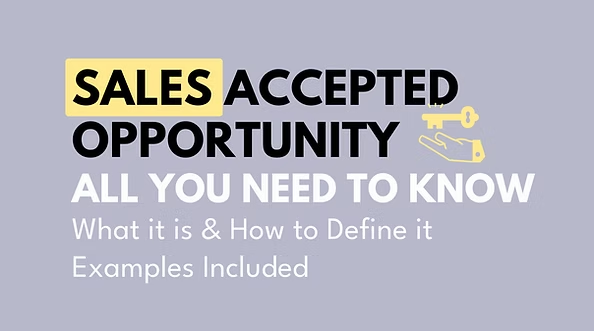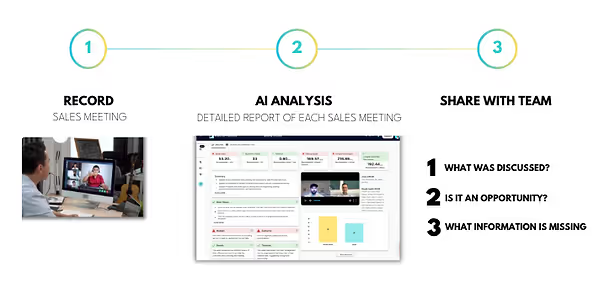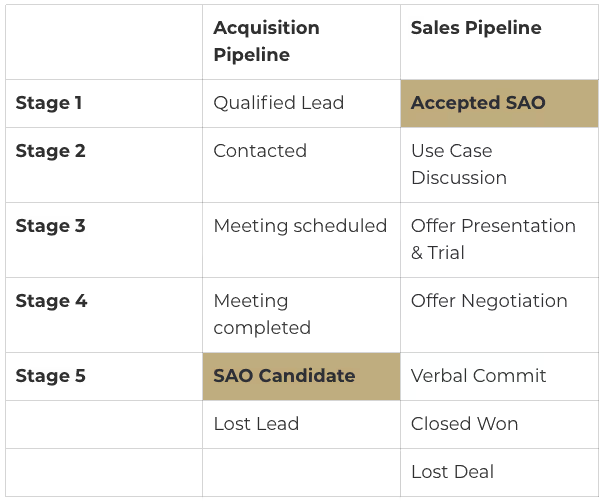Sales Accepted Opportunity (SAO): All You Need To Know

What is a Sales Accepted Opportunity (SAO)
A sales accepted opportunity (SAO) is a qualified lead or prospect that has been vetted and approved by the sales and business development team, and is ready to be worked on by direct or field sales reps.
The sales and business development team, SDRs, BDRs, and their managers, have typically reviewed the lead's contact information, their level of interest or need, and other relevant criteria to determine whether the lead has a high probability of converting into a customer.
Once a lead has been accepted as an SAO, it is handed off to the direct or field sales reps (Account Executives) for further engagement and nurturing.
SAOs are important because they represent a higher-quality lead that is more likely to result in a sale.
By focusing their efforts on SAOs, sales reps can increase their efficiency and effectiveness, and ultimately drive more revenue for the business.
SAOs can be generated through a variety of marketing and sales channels, including inbound marketing campaigns, outbound prospecting, and referrals.
The Challenges with SAOs
While SAOs are a crucial part of the sales process, they also come with a set of challenges that businesses must be prepared to overcome.
Most B2B sales teams miss a clear definition and a clear handover process of Sales Accepted Opportunities.
A clear definition and a clear handover process are essential to not miss out on great opportunities and hold every one on the sales team accountable.
Some of these challenges include:
- Quality of SAOs: One of the biggest challenges with SAOs is ensuring that they are of high quality.The SDR and BDR team will push SAOs to the direct sales team, and most of the time they push as much as possible as they get compensated on SAOs.Sales reps and Account Executives on the other hand side need to be careful not to accept leads that are not truly qualified or have a low chance of converting into customers.Otherwise, they may waste valuable time and resources on leads that will never result in a sale. A lot of companies struggle with defining what a sales-accepted opportunity actually is.Below you find an example definition of SAOs to make sure the hand over process between SDRs/BDRs to sales reps and Account Executives is smooth.
- Managing SAOs: Once SAOs are accepted, they need to be properly managed and nurtured.Sales reps need to stay on top of their SAOs, ensuring that they are moving through the sales funnel in a timely manner and receiving the right level of attention.In most cases, this doesn't happen as some SAOs have low quality and they are not top of mind of the sales rep.Sales teams not only waste valuable time but also revenue potential not following up on SAOs.
- Time management: Sales reps may have a large number of SAOs to manage at any given time, which can make it difficult to prioritize and manage their time effectively.They need to be able to identify which SAOs are the most promising and allocate their time and resources accordingly.Ideally, the SDR and BDR team only hands over SAOs with a high probability of really moving forward.
- Metrics and Reporting: In order to track and measure the effectiveness of their sales process, businesses need to have clear metrics and reporting in place.This can be a challenge when dealing with SAOs, as the data can be complex and difficult to measure accurately.
Example Criteria of a Sales Accepted Opportunity
Criteria 1 (MUST) - Qualification Meeting is completed
Only if an official qualification meeting between potential buyers and your sales/business development team happened, it can be a sales accepted opportunity.If there was no formal meeting, it never will turn into a formal opportunity. Especially if you are an enterprise B2B organization.
Criteria 2 (MUST) - Follow-Up Meeting is scheduled and sales rep is part of it
Only if an official follow-up meeting is scheduled where the sales rep (= Account Executive) is already involved this can turn into an SAO.
Once this meeting is completed, the sales rep has to decide if they want to accept the opportunity or not.
If they accept it, the SDR and BDR gets credit.
Criteria 3: General qualification fulfilled
Typically this is
(1) NEED - Before Scenario incl. negative consequences - After Scenario incl. positive business outcomes AND[ (2) METRICS (# of Users or other impacted metrics costs/revenue) OR (3) ECONOMIC BUYER OR (4) TIMELINE]
I'm not the biggest fan of qualifying for BANT, as in technical B2B sales processes this isn't the right approach.
But ... the need has to be defined clearly. Ideally, you figure out what your potential buyer uses right now and what problems they have today and give them the path into the future and the positive business outcomes they are going to achieve with your solution.
Criteria 4: Customer-specific qualifications fulfilled
Criteria 1-3 you can copy as it is. Criteria #4 you need to work on.
Depending on your product and service, you have to define further criteria defining it as a sales accepted opportunity.
This can be for example:
- Specific hardware your potential buyer already has (e.g. VR or XR devices)
- Specific software your potential buyer already uses (e.g. Hubspot etc.)
- A dedicated department for solving a certain problem (e.g. encoding department)
- A dedicated current solution (e.g. having right now an in-house video player, etc.)
Example Criteria Checklist
✅ Qualification Meeting is completed
✅ Follow-Up Meeting is scheduled and AE is involved
✅ General Qualification fulfilled
✅ NEED (1) - Before Scenario incl. negative consequences - After Scenario incl. positive business outcomes AND[ (2) METRICS (# of Users or other impacted metrics costs/revenue) OR (3) ECONOMIC BUYER OR (4) TIMELINE]
✅ Customer Specific Qualifications fulfilled
- Your own qualification criteria
- Your own qualification criteria
We recommend you build a process to track the qualification meetings automatically. You can use sales conversation intelligence tools that record & analyze every meeting which you can then share between the team. This way it's easy to see if it is really an opportunity or not.

Sales Pipelines to hand-over SAOs
We recommend having two different sales pipelines to manage sales accepted opportunities properly.
One pipeline for all SAOs not yet accepted by the direct sales team, and one pipeline for the SAOs that got accepted.
This pipeline can be your normal sales pipeline.

Here is what an acquisition pipeline can look like for sales & business development teams

Once a lead is marked as sales accepted opportunity, it enters the New sales pipeline. Example below.

Conclusion
Overall, SAOs can be a valuable part of the sales process and every B2B enterprise sales organization need a concept for generating SAOs for the direct sales team.
But, SAOs require careful management and attention in order to be successful. Businesses that are able to overcome these challenges and effectively manage their SAOs will be well-positioned for success in the long run.Here are some more resources that you might be interested in:


Your sales team deserves clarity instead of guessing games
With our AI revenue intelligence platform, we help innovative sales teams make better decisions and close more deals. Experience the difference:
Deep customer understanding
Identify why customers buy or what prevents them from doing so – from all conversations
Objective forecasts
Finally make decisions based on hard facts instead of gut feeling
Deal prioritization
Focus your team on the opportunities with the highest potential




















